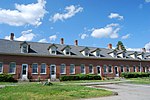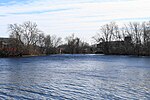Old Furnace State Park
1918 establishments in ConnecticutKillingly, ConnecticutParks in Windham County, ConnecticutProtected areas established in 1918State parks of Connecticut ... and 1 more
Use mdy dates from August 2023

Old Furnace State Park is a public recreation area adjacent to Ross Pond State Park in the town of Killingly, Connecticut. The state parks covers 367 acres (149 ha), sits at an elevation of 390 feet (120 m), and is open year-round for hiking, hunting, and fishing. It is located east of Interstate 395, south of U.S. Route 6 and north of Connecticut Route 695. The park is the site of a former iron furnace. It was established as a town park in 1909 before being transferred to the state in 1918.
Excerpt from the Wikipedia article Old Furnace State Park (License: CC BY-SA 3.0, Authors, Images).Old Furnace State Park
Ross Road,
Geographical coordinates (GPS) Address External links Nearby Places Show on map
Geographical coordinates (GPS)
| Latitude | Longitude |
|---|---|
| N 41.781944444444 ° | E -71.866944444444 ° |
Address
Old Furnace State Park
Ross Road
06239
Connecticut, United States
Open on Google Maps








